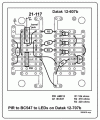Hello AAC forum,
Have a couple of projects complete, couple in flight, and several
planned using a PIR sensor (hc-sr501) to control LEDs. The applications
are in closets, stairways and cabinets.

Have used this Simple PIR Circuit as a sort PIR component
tester but am thinking about a tester that also includes
a transistor.

The simple circuit is one found on line. The PIR to BC547
to LEDs is an extension of that based on one found at
PIR_to_Transistor_to op_amp
The question is: Is the R4 resistors necessary?
It seems like R3 is limited the flow of current from the positive rail.
But not sure it would protect the LEDs.
Thanks.
Allen in Dallas
Have a couple of projects complete, couple in flight, and several
planned using a PIR sensor (hc-sr501) to control LEDs. The applications
are in closets, stairways and cabinets.

Have used this Simple PIR Circuit as a sort PIR component
tester but am thinking about a tester that also includes
a transistor.

The simple circuit is one found on line. The PIR to BC547
to LEDs is an extension of that based on one found at
PIR_to_Transistor_to op_amp
The question is: Is the R4 resistors necessary?
It seems like R3 is limited the flow of current from the positive rail.
But not sure it would protect the LEDs.
Thanks.
Allen in Dallas
Attachments
-
258.9 KB Views: 15














